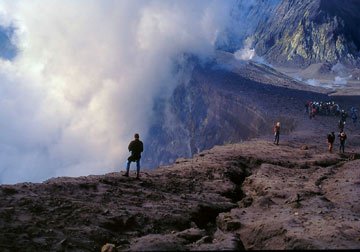|
NEWS NOTES
Geochemistry
Volcanoes may have swallowed early Earth’s oxygen
| New research suggests that early Earth did have oxygen during parts of the Archean, but volcanoes such as this one at White Island in New Zealand swallowed it up, thus preventing life from thriving. |
Many scientists have thought that up until about 2.5 billion years ago Earth’s atmosphere was suffocating — devoid of the oxygen that makes modern-day life possible. But evidence found in old rocks indicates that about 200 million years prior to that, photosynthetic cyanobacteria began producing oxygen at rates similar to today’s (see Geotimes, November 2006). As there was no aerobic life to consume all that gas, however, exactly where it all went has remained a mystery.
Now, Lee Kump of NASA’s Astrobiology Institute and Pennsylvania State University in University Park and Mark Barley of the University of Western Australia in Crawley have found a possible explanation: In the Aug. 30 Nature, the team suggests that oxygen-hungry gases spewed out by the large number of undersea volcanoes present during the Archean — between 3.8 billion and 2.5 billion years ago — devoured oxygen as quickly as it was produced, preventing the gas from accumulating in the atmosphere.
The team gathered a large dataset of volcanic activity through time and looked for clues that could explain a strange coincidence, Kump says. “Two seemingly unrelated events happened during the Archean-Proterozoic transition about 2.5 billion years ago,” he says. One of these events was a major change in the atmospheric composition, from oxygen-devoid to oxygen-rich, he says. The other was a major tectonic event, the formation and thickening of continental crust that caused volcanoes to move from the seafloor to land.
Submarine volcanoes release gases such as carbon monoxide, methane and hydrogen sulfide. “These react vigorously with oxygen and essentially strip it from the ocean. Then these gases escape into the atmosphere and mop up any oxygen that might be lingering around there,” Kump says, comparing the atmosphere to a huge bathtub. The oxygen-producing cyanobacteria acted like a faucet, while all the underwater volcanism during the Archean served as a large drain. “Even though the faucet was pouring oxygen into the atmosphere, nothing was accumulating in the bathtub because the drain was so big,” he says.
Unlike their submarine counterparts, volcanoes erupting on land pump out gases, such as carbon dioxide, that do not react with oxygen. That means that the change from predominantly submarine to terrestrial volcanism caused the oxygen drain to shrink, allowing the gas to build up in the atmosphere, Kump says.
“Scientists have known for a long time that these major tectonic events happened at the same time as the atmosphere was changing and the question was ‘What’s the cause and effect relationship?’” says Tim Lyons of the University of California at Riverside. “Now Kump and Barley have put the pieces together and it all makes sense,” he says.
“I like this story because it is sort of an advance beyond Darwinian evolution,” Kump says. “In Darwin’s survival of the fittest, you have an environmental change that then drives a biological change.” Here, he says, “we have a biological innovation, namely the origin of oxygen-producing cyanobacteria,” but that did not have an environmental impact at the onset. Instead, there was “an evolutionary bottleneck” that prevented the development of oxygen-loving organisms for about 200 million years, he says. Only after major tectonic events occurred could new species take advantage of the oxygen, he says. “This shows that life and environment are co-evolving.”
Links:
www.flickr.com/photos/nzdave
"Airing out an early atmosphere," Geotimes, November 2006

 Subscribe
Subscribe



